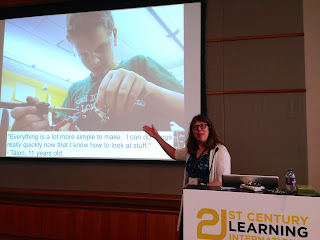“Learning is about experiencing something firsthand.” ~Sylvia Martinez
Sylvia started out as an electrical engineer who began her career in the aerospace industry, then moved to video game development, among which she created educational games. As she remarked, she, like several engineers, liked teaching children, and this desire to find out how people learned was what led her to get a postgraduate degree in education. She learned that the present generation of children didn’t have the kind of hands-on experiences she had while growing up, and this was part of the reason she teamed up with her co-author, Gary Stager, who has been teaching robotics and programming for thirty years, to write a book and make the so-called Maker Movement understandable to teachers and the general public.
The Maker Movement is a worldwide movement found in such countries as The Netherlands, Italy and India, wherein ordinary people take matters into their own hands to create things on their own, usually with the aid of computers and a three-dimensional (3D) printer, which is a printer that lays down layer after layer of plastic to create an item or a form, such as prosthetics and moisture sensors, relatively inexpensively and quickly, compared to present-day manufacturing processes. She notes that the wave is catching a lot of people unprepared and foresees a time when designs for three-dimensional printers can be bought on Amazon in the same way books are, and that three-dimensional printers themselves will become as commonplace as regular printers are nowadays.
Computers, Sylvia points out, are important to the Maker Movement, as these allow children to create iterative designs similar to the way engineers create their own designs in the real world, creating a real-world experience for children when it comes to experimentation and problem solving. Sylvia also notes that using computers to create objects is a fusion of art and science, as a knowledge of both is necessary to create something using a three-dimensional printer, which is actually more the case in the real world. She gave the example of a website called “Enable the Future,” where requests for prosthetic devices can be made, and the requests can be filled by children who have access to three-dimensional printers far more cheaply and inexpensively than by going through conventional channels.
She remarks that the Maker Movement ties in with the way kids should learn, by tackling their own problems, figuring things out on their own and making things that really work, effectively combining art and science, rather than having these separated, as they are in present-day conventional education, for purposes of efficiency. Sylvia remarks that studies, such as those being done by the Graduate Schools of Education of both Harvard and Stanford, are presently being conducted, which are pointing out that kids need to “mess around” to learn effectively, and those who have had the kind of experiences the Maker Movement offers feel that they can solve problems, which increases their confidence in their own capabilities. Children, she points out, learn by exploration and experience, and this was also pointed out by such educational experts as John Dewey and Jean Piaget, and remarks that these experts had been saying this for decades now.
 Sylvia notes that the present educational system could be more improved to align with the way children learn, and gives tests as an example, for while tests might be useful in figuring out what a child doesn’t know, these don’t give an accurate picture of what the child already knows. She also notes that the same subjects have been taught in the same way for generations, and that these could be out of date, as in the case of mathematics, which has undergone a tremendous expansion since the end of World War II, yet remain unengaging to children, as in the case of history, where past events are taught as a series of dates that need to be memorized.
Sylvia notes that the present educational system could be more improved to align with the way children learn, and gives tests as an example, for while tests might be useful in figuring out what a child doesn’t know, these don’t give an accurate picture of what the child already knows. She also notes that the same subjects have been taught in the same way for generations, and that these could be out of date, as in the case of mathematics, which has undergone a tremendous expansion since the end of World War II, yet remain unengaging to children, as in the case of history, where past events are taught as a series of dates that need to be memorized.Sylvia is involved with CMK Press, which produces books that deal with the Maker Movement, and on a personal note, is considering writing a book about girls and science and engineering education.
Sylvia Martinez’s website for her book, Invent to Learn: Making, Tinkering and Engineering in the Classroom, is inventtolearn.com.
Purchase on Amazon: Invent to Learn: Making, Tinkering and Engineering in the Classroom

No comments:
Post a Comment